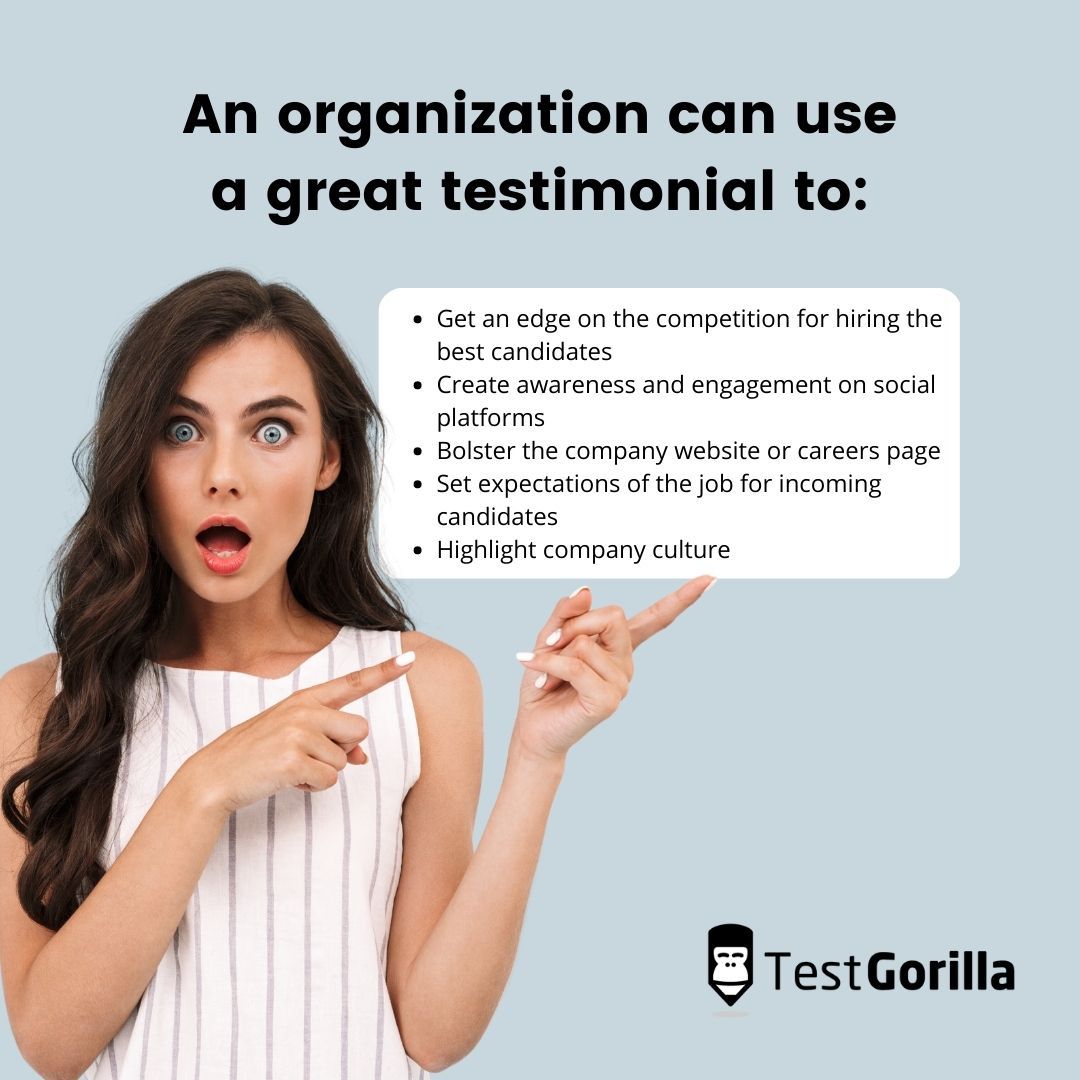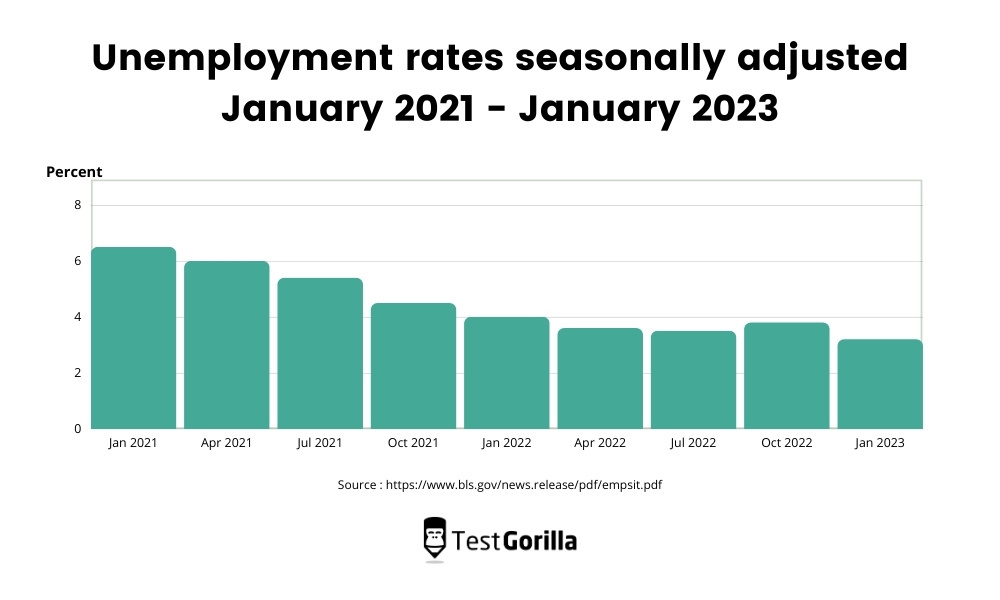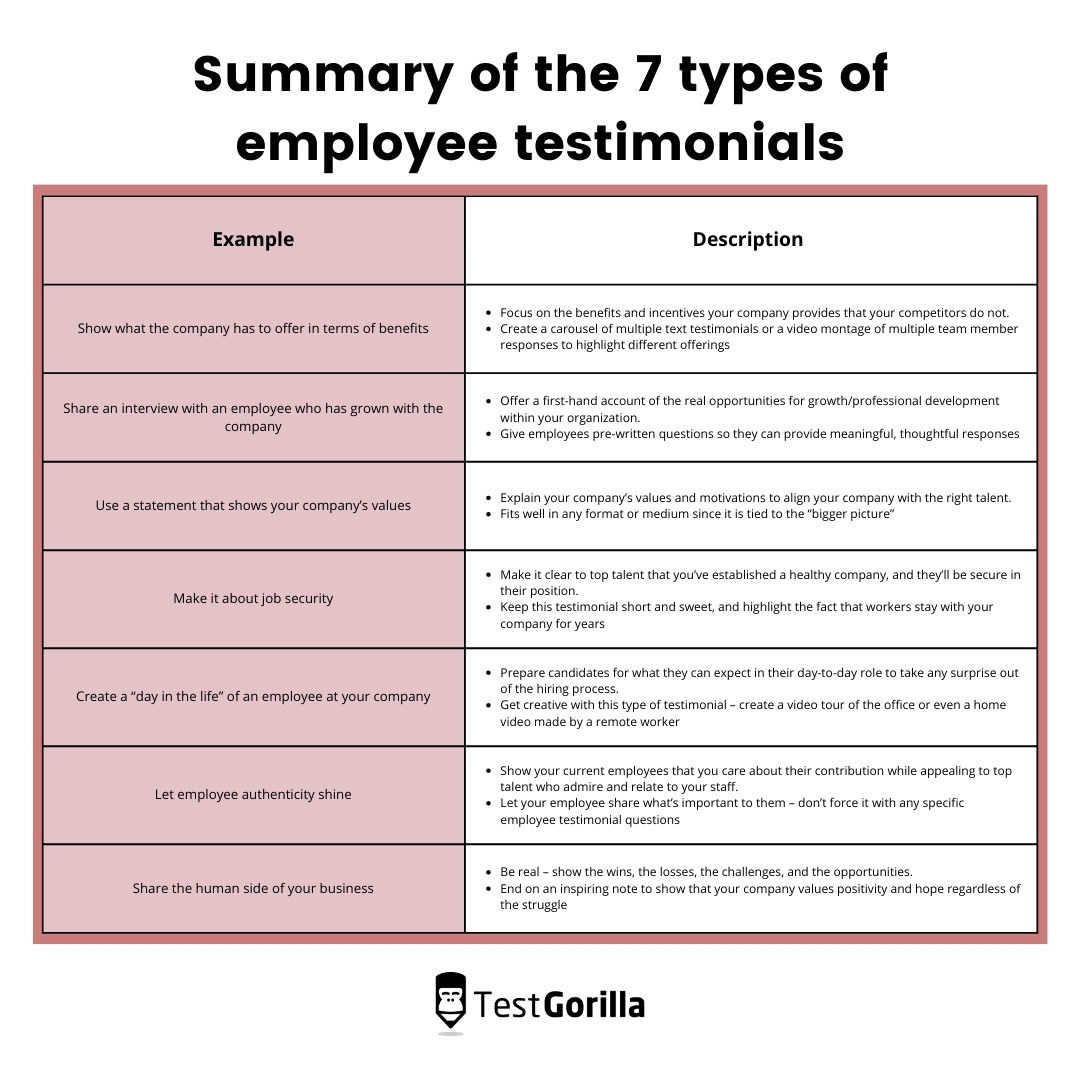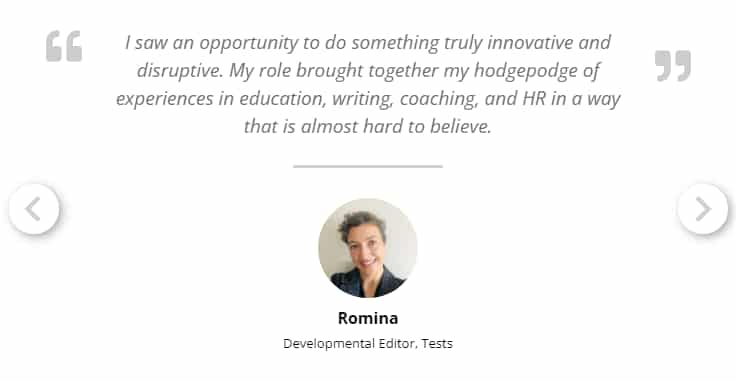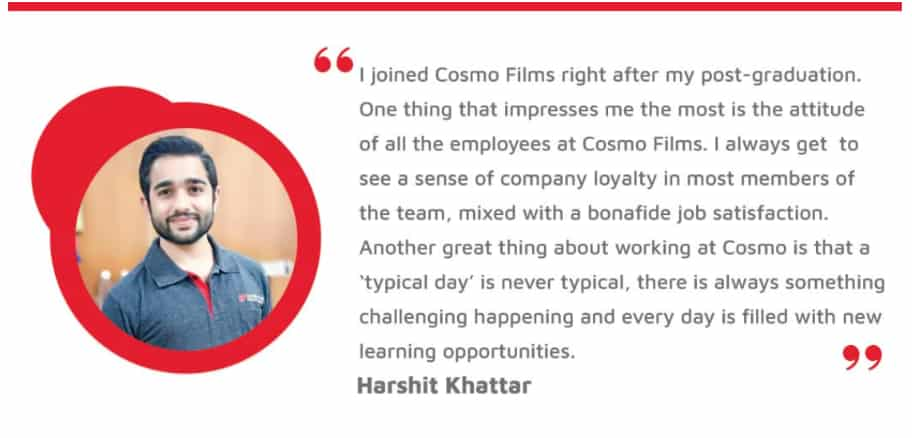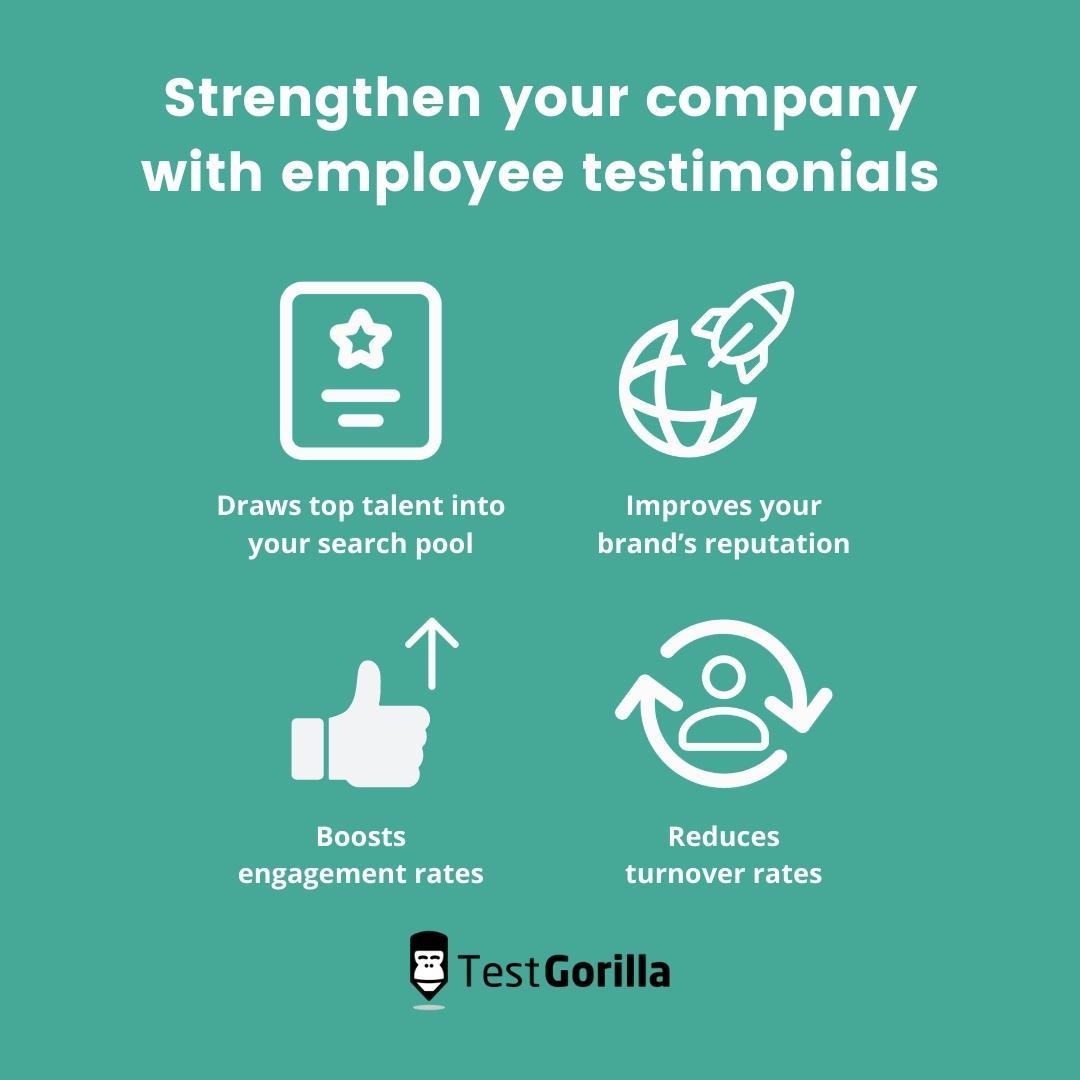7 types of employee testimonials to attract the best candidates
With unemployment at its lowest in the last 50 years,[1] there’s heavy competition when it comes to finding and securing top talent.
A brand must be able to earn candidates’ trust if they want to recruit the best, which is only possible by building a great reputation.
Employee testimonials are non-negotiable if you’re hoping to source the best talent.
Employee testimonials are social proof of a brand’s reputation given by the candidate’s future peers – a source they’re more likely to trust than an HR rep.
What’s more, testimonials give job candidates candid insight into the role and your company’s culture, so you avoid culture mismatches because the candidate knows what they’re getting.
So what makes an employee testimonial stand out, and how do you use them effectively?
Read on to find out.
What is an employee testimonial?
An employee testimonial is a published statement that an employee gives about their company. While employee testimonials can discuss almost anything about the employee’s experience at the company, common topics include:
Personal insights
Roles and responsibilities
Company culture
Day-to-day duties
Recommendations
Career progression
Testimonials are more than just a review from an employee, however. They’re social proof of a brand’s reputation and help a company achieve important goals.
An organization can use a great testimonial to:
Get an edge on the competition for hiring the best candidates
Create awareness and engagement on social platforms
Bolster the company website or careers page
Set expectations of the job for incoming candidates
Highlight company culture
Why employee testimonials are non-negotiable for employer branding
While employee testimonials may seem like little more than a simple way to bulk up your company’s careers page, they’re incredibly valuable to HR teams in many different ways.
Benefit | Summary |
Cultivate trust | Candidates get to hear first-hand from their peers about your company’s reputation, giving you an upper hand on competing brands |
Reduce turnover | Testimonials provide candidates a direct view into life at your organization so they know what they’re getting, which reduces turnover |
Increase awareness and engagement | Image and video testimonials are easily shared and seen on social media accounts, boosting your presence to prospective talent |
First, employee testimonials help HR teams get an edge over the competition by cultivating trust for their brand.
Because unemployment is incredibly low at only 3.5%, there’s plenty of competition among companies to draw in the best talent and show them that there are growth opportunities beyond their current position.
But candidates don’t always believe every claim made in the job ads or recruitment marketing emails that land in their inboxes.
Great candidates are skeptical of whether or not a role provides what they’re looking for (like a positive culture, job security, a healthy work-life balance, and attention to wellbeing).
So to ease that skepticism, they research the company’s reputation. Consider that 97% of employees looking to change jobs check a potential employer’s reputation, and 55% of those abandon their application if they find negative reviews.[2]
However, these testimonials must be authentic – real employees sharing real experiences. The further from appearing as though a brand has constructed the testimonial, the more persuasive and trustworthy it becomes.[3]
HR teams can foster a trustworthy brand reputation by cultivating great employee testimonials. As a result, they gain the upper hand over competing brands.
Second, testimonials help reduce employee turnover by setting expectations for prospective candidates.
With testimonials, you’re giving job seekers a chance to see inside your company and work environment before they actually land the role. This helps avoid nasty surprises, which lead to early terminations or resignations and, as a result, higher employee turnover.
To top it off, testimonials like “a day in the life” videos show a peek into what candidates can expect from the role and limit surprises about the weight of their responsibilities. This reduces unforeseen overwork or burnout by ensuring the candidates who apply can handle the workload they’re signing up for.
In fact, companies with stronger employer branding reduce their turnover by 28%.[4]
Lastly, you can post employee testimonials on social platforms to increase awareness and engagement.
Having top talent see great reviews on social media is a solid way to take a bit of the heavy lifting off HR’s shoulders. When candidates see these reviews, they naturally take an interest in your company, smoothing out the recruitment process on your end.
To sum up, employee testimonials are a must-have in this day and age. Employers and HR managers should be as invested in employee reviews as they are in customer reviews and case studies because, in the end, they help you draw in and retain top talent.
The best insights on HR and recruitment, delivered to your inbox.
Biweekly updates. No spam. Unsubscribe any time.
7 types of employee testimonials (with examples and tips)
So, we know why employee testimonials are a no-brainer, but what kinds should you make, where should you put them, and how should you make them?
To start, you can put employee testimonials just about anywhere.
We recommend including plenty on your careers page, your social media channels, and even within your job postings on career boards. You may even have a dedicated testimonial page.
They can vary in format, goal, and medium, and each has its own purpose and value. Formats include:
Employee testimonial videos
Images with short text
Long-form text, such as articles
To help you craft the best for your brand, we’ve narrowed it down to our seven favorite types of employee testimonials.
Summary of the 7 types of employee testimonials
Here’s a quick rundown of employee testimonial examples.
Example | Description |
Show what the company has to offer in terms of benefits | Focus on the benefits and incentives your company provides that your competitors do not; Create a carousel of multiple text testimonials or a video montage of multiple team member responses to highlight different offerings |
Share an interview with an employee who has grown with the company | Offer a first-hand account of the real opportunities for growth/professional development within your organization; Give employees pre-written questions so they can provide meaningful, thoughtful responses |
Use a statement that shows your company’s values | Explain your company’s values and motivations to align your company with the right talent; Fits well in any format or medium since it is tied to the “bigger picture” |
Make it about job security | Make it clear to top talent that you’ve established a healthy company, and they’ll be secure in their position; Keep this testimonial short and sweet, and highlight the fact that workers stay with your company for years |
Create a “day in the life” of an employee at your company | Prepare candidates for what they can expect in their day-to-day role to take any surprise out of the hiring process; Get creative with this type of testimonial – create a video tour of the office or even a home video made by a remote worker |
Let employee authenticity shine | Show your current employees that you care about their contribution while appealing to top talent who admire and relate to your staff; Let your employee share what’s important to them – don’t force it with any specific employee testimonial questions |
Share the human side of your business | Be real – show the wins, the losses, the challenges, and the opportunities; End on an inspiring note to show that your company values positivity and hope regardless of the struggle |
1. Show what the company has to offer in terms of benefits
There are two top factors that employees search for when looking at a new job:
Greater benefits
Better work-life balance
By including these details in your employee testimonials, you show candidates that your company can give them what they want from a job.
Check out this example from DCI Consulting:
Better yet, you’re doing it through the social proof of employee testimonials, which organically attracts top candidates, so your team doesn’t have to spend as much time and budget trying to find them.
To create this type of testimonial, ask directed questions to employees, so they can share what benefits and incentives improve their quality of life the most.
Remember that everyone has their own reasons for valuing different benefits and incentives, so you can expect mixed responses. For this reason, having a carousel of multiple text testimonials or a video montage of multiple employee responses are great ways to execute this type of testimonial.
2. Share an interview with an employee who has grown with the company
This type of testimonial is great for showing how your HR team uses skills-based hiring, which means staff aren’t pigeon-holed into a single role and instead are hired based on skills that fit well within the company as a whole.
For example, in the Vertex Pharmaceuticals employee testimonial above, the review highlights internal mobility, telling watchers that there are long-term opportunities at the business – that there’s room to grow, progress, and develop.
And with nearly seven out of 10 workers suggesting they’d be willing to give up part of their salary for job security assurance, showing that long-term stability in front of them is a great way to draw in top talent.[2]
While videos are a solid way to get up close and personal, this type of testimonial also works nicely as a long-form article in question-and-answer format.
To create this type of testimonial, it’s best to pre-write the questions and give them to the interviewee so they have time to prepare, be insightful, and be fully honest and confident while they speak.
Make sure to ask questions that give the interviewee the chance to show what it’s like to be with the company (at both the beginning of their journey and their present situation).
If this is a long-form article, you can bring a content writer into the team to write the article and include pictures to break up the text throughout to make it easier to read.
3. Use a statement that shows your company’s values
With a values statement testimonial, the goal is to showcase your company’s motivations so that you align your company with the right talent.
By creating a value-driven testimonial, you catch the eye of candidates with similar motivations and increase the odds of finding solid culture adds for your organization.
Our own employee testimonial here from Romina, our Developmental Editor, shows potential candidates what’s important to us – innovation. If that’s something the applicant puts high stock in as well, it’s a clue that we may be a great match.
These testimonials also show candidates what to expect from your business, creating less opportunity for surprises while in talks with your HR team throughout the hiring process. That means it’s a great way to reduce high employee turnover of newly hired staff who weren’t a great fit for the role.
When deciding on a format for this type of testimonial, the world is your oyster. Why? Because this type of testimonial can easily be a video, photo with a quote, or just a quick text snippet and still make a big impact on your audience.
To create this type of testimonial, prompt the employee writing the statement to share what they value most and how it applies to the time they’ve spent with your company or how it aligned with what they were looking for in their initial interviewing stages.
4. Make it about job security
Top talent looks for a company that they can grow with. In a survey, Randstad found more than 21% of employees would give up 10% of their salary in exchange for job security.[2]
In uncertain economic situations, candidates look for companies that offer financial security. But it’s not always easy to convey that message properly in an interview. An employee testimonial is a fantastic, impactful way to display the job security that your company provides.
It also shows there are opportunities for growth and the chance to develop leadership skills within your organization.
This type of testimonial is great in photo and text block format like the example below, or even just text format.
To create this type of testimonial, make it short and sweet and highlight that workers stay with your company for years to get the point across without clouding the message.
5. Create a “day in the life” of an employee at your company
A “day in the life” employee testimonial is a heavy-hitter for multiple reasons.
First, you showcase your company culture to attract potential employees who can help you grow and develop it.
Second, you prepare candidates for what to expect in their day-to-day role and what the company expects from them. This takes any surprise from the interview, hiring, and onboarding process, making your HR team’s jobs much easier.
For example, if a candidate isn’t comfortable with challenging, atypical days like the ones depicted above, this testimonial lets them know that this may not be the role for them. This saves both HR and the candidate time, money, and effort by avoiding a bad hire.
“Day in the life” testimonials can be:
A picture and a statement text block, or
A video
We highly recommend using visuals for these testimonials because images and videos help candidates picture themselves in the employee’s shoes.
To create this type of testimonial, get creative. For example, include a video tour of the office or even a home video made by a remote worker.
We particularly like the video route because it’s engaging and does well on social media channels. If you plan on sharing it on social media, make sure to format it according to the medium’s required dimensions.
6. Let employee authenticity shine
Having current employees share their positive experiences with your company not only attracts great talent but also shows that you value the talent you’re currently employing.
These types of testimonials – employee stories – let your staff feel heard and celebrated on your site, showing them that their contribution creates a cohesive work culture. When you make your employees feel valued, you reduce employee turnover while showing potential applicants that job satisfaction is important to you.
This testimonial is all about highlighting your employees’ personalities and stories (and perhaps a bit of their personal lives), so we recommend either creating a video or using a photo with text, like in the example below.
To create this type of testimonial, you can present the employee with directed questions, but don’t force it.
Let the employee tell their story in their authentic way. The goal of this type of testimonial is to give your employees a chance to share their stories in a way that’s meaningful to them.
7. Share the human side of your business
Companies pretending to have never had losses throw up red flags for discerning candidates. Instead, be real. Show the wins, the losses, the challenges, and the opportunities.
By spotlighting the more human side of your business, you draw in top talent who are looking for the real deal.
Great companies “tackle great problems,” as Capital One says. Jobs that matter have challenges that need to be overcome. When you put those challenges in the foreground, you attract great talent who want to help your company overcome them.
To create this type of testimonial, make a video or article that shares a story about the wins and losses. These can be specific examples of challenges the team or company has overcome, or they can be framed in a larger context, like the video above.
Regardless of how you format it, ensure it ends on an inspiring note to show that your company values positivity and hope regardless of the losses that came before the wins.
Strengthen your company with employee testimonials
Employee testimonials are great for attracting top candidates by using real, human insights to cultivate trust and showcase a brand’s reputation in the right ways.
Smartly incorporating testimonials into your recruitment strategy provides a number of tangible benefits:
Draws top talent into your search pool
Improves your brand’s reputation
Boosts engagement rates
Reduces turnover rates
By using testimonials properly, you strengthen your organization as a whole.
Struggling to get started?
If you’re having a hard time getting positive employee testimonials from your company’s staff, check out our article on job satisfaction factors and how to improve them.
Also, try our Communication test to find top candidates who might just write your next glowing testimonial.
Sources
Horsley, S. (August 5, 2022). “The unemployment rate fell to 3.5%, matching its lowest level in the last 50 years”. NPR. Retrieved February 6, 2023. https://www.npr.org/2022/08/05/1116036160/the-unemployment-rate-fell-to-3-5-matching-its-lowest-level-in-the-last-50-years
“Employer Brand Research 2019”. (2019). Randstad. Retrieved February 5, 2023. https://cdn2.hubspot.net/hubfs/481927/REBR%20Global%20report%202019.pdf
Lacka-Badura, Jolanta. (June 2018). “Building Employer Brands through Employee Testimonials: The Linguistic Expression of Values”. Cambridge Scholars Publishing. Retrieved February 3, 2023. https://www.researchgate.net/publication/331386130\_Building\_Employer\_Brands\_through\_Employee\_Testimonials\_The\_Linguistic\_Expression\_of\_Values
“Why Your Employer Brand Matters”. (2012). LinkedIn. Retrieved February 20, 2023. https://business.linkedin.com/content/dam/business/talent-solutions/global/en\_US/site/pdf/datasheets/linkedin-why-your-employer-brand-matters-en-us.pdf
Related posts
You've scrolled this far
Why not try TestGorilla for free, and see what happens when you put skills first.


